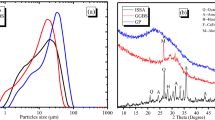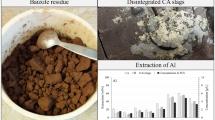Abstract
In this study, natural volcanic tuff-based foamed geopolymer was synthesized, characterized, and evaluated for its efficiency to remove heavy metals (zinc and lead) from wastewater. Sodium hydroxide was used as an alkaline activator to dissolve the constituents and form geopolymeric binders. Hydrogen peroxide (H2O2) was used as a foaming agent at different levels (0%, 1%, and 2%). The effect of curing temperature (60, 80, and 100 °C) on the physical properties and the removal efficiency was evaluated with a pH ranging from 3 to 7 for lead removal and 5 to 7 for zinc removal. The physical properties include compressive strength, density, and microstructural characteristics. The results indicated that higher curing temperatures increase the compressive strength and removal efficiency of the geopolymer foam. Geopolymers that are prepared at a curing temperature of 100 °C exhibited the highest removal efficiency for both Pb2+ and Zn2+ ions. The addition of H2O2 refined the microstructural characteristics of the foamed geopolymer and increased the efficiency of the zinc removal process. Results revealed that as the pH increases, the removal efficiency also increases. This can be due to the competition between H+ and Pb2+ and Zn2+ ions on the available adsorption sites at low pH values. As the acidity of the solution decreases, this competition decreases and led to higher removal efficiency.
Article Highlights
-
Foam-based volcanic tuff geopolymer was synthesized and characterized.
-
The geopolymer efficiency for heavy metal removal was evaluated.
-
Increasing geopolymer curing temperature led to enhancing the removal efficiency.
-
Increasing the foaming agent dosage has enhanced the removal efficiency.














Similar content being viewed by others
References
Ababneh A, Matalkah F (2018) Potential use of Jordanian volcanic tuffs as supplementary cementitious materials. Case Stud Constr Mater 8:193–202
Abdollahnejad Z et al (2015) Mix design, properties and cost analysis of fly ash-based geopolymer foam. Constr Build Mater 80:18–30
Abdullah MMAB et al (2012) Fly ash-based geopolymer lightweight concrete using foaming agent. Int J Mol Sci 13(6):7186–7198
Al Bakria AM et al (2011) The effect of curing temperature on physical and chemical properties of geopolymers. Phys Procedia 22:286–291
Alghamdi HSG (2019) Novel materials and processing routes using alkali-activated systems. Arizona State University, Tempe
Al-Ghouti MA et al (2020) Application of geopolymers synthesized from incinerated municipal solid waste ashes for the removal of cationic dye from water. PLoS ONE 15(11):e0239095
Al-Zboon KK, Al-smadi BM, Al-Khawaldh S (2016a) Natural volcanic tuff-based geopolymer for Zn removal: adsorption isotherm, kinetic, and thermodynamic study. Water Air Soil Pollut 227(7):1–22
Al-Zboon KK et al (2016b) Natural volcanic tuff-based geopolymer for Zn removal: adsorption isotherm, kinetic, and thermodynamic study. Water Air Soil Pollut 227(7):1–22
Barakat MA (2011) New trends in removing heavy metals from industrial wastewater. Arab J Chem 4(4):361–377
Bolong N et al (2009) A review of the effects of emerging contaminants in wastewater and options for their removal. Desalination 239(1–3):229–246
Cheng-Yong H et al (2017) Thermal resistance variations of fly ash geopolymers: foaming responses. Sci Rep 7(1):1–11
Feng J et al (2015) Development of porous fly ash-based geopolymer with low thermal conductivity. Mater Des 65:529–533
Hajimohammadi A et al (2017) Regulating the chemical foaming reaction to control the porosity of geopolymer foams. Mater Des 120:255–265
Hassett JJ (1974) Capacity of selected Illinois soils to remove lead from aqueous solution. Commun Soil Sci Plant Anal 5(6):499–505
Henon J et al (2012) Porosity control of cold consolidated geomaterial foam: temperature effect. Ceram Int 38(1):77–84
Jamil NH et al (2020) Influences of SiO2, Al2O3 CaO and MgO in phase transformation of sintered kaolin-ground granulated blast furnace slag geopolymer. J Market Res 9(6):14922–14932
Jaya NA et al (2020) Correlation between pore structure, compressive strength and thermal conductivity of porous metakaolin geopolymer. Constr Build Mater 247:118641
Ji Z et al (2020) Porosity, mechanical strength and structure of waste-based geopolymer foams by different stabilizing agents. Constr Build Mater 258:119555
Ji Z, Su L, Pei Y (2021) Characterization and adsorption performance of waste-based porous open-cell geopolymer with one-pot preparation. Ceram Int 47(9):12153–12162
Kani EN et al (2012) Efflorescence control in geopolymer binders based on natural pozzolan. Cement Concr Compos 34(1):25–33
Khattri S, Singh MK (2009) Removal of malachite green from dye wastewater using neem sawdust by adsorption. J Hazard Mater 167(1–3):1089–1094
Le VS, Louda P (2021) Research of curing time and temperature-dependent strengths and fire resistance of geopolymer foam coated on an aluminum plate. Coatings 11(1):87
Luukkonen T et al (2017) Optimization of the metakaolin geopolymer preparation for maximized ammonium adsorption capacity. J Mater Sci 52(16):9363–9376
Luukkonen T et al (2018) Removal of ammonium from municipal wastewater with powdered and granulated metakaolin geopolymer. Environ Technol 39(4):414–423
Lynch JLV et al (2018) Preparation, characterization, and determination of mechanical and thermal stability of natural zeolite-based foamed geopolymers. Constr Build Mater 172:448–456
Masi G et al (2014) A comparison between different foaming methods for the synthesis of light weight geopolymers. Ceram Int 40(9):13891–13902
Matalkah F, Aqel R, Ababneh A (2020) Enhancement of the mechanical properties of kaolin geopolymer using sodium hydroxide and calcium oxide. Procedia Manuf 44:164–171
Meroufel B et al (2013) Adsorptive removal of anionic dye from aqueous solutions by Algerian kaolin: characteristics, isotherm, kinetic and thermodynamic studies. J Mater Environ Sci 4(3):482–491
Mittal A, Kurup L, Mittal J (2007) Freundlich and Langmuir adsorption isotherms and kinetics for the removal of Tartrazine from aqueous solutions using hen feathers. J Hazard Mater 146(1–2):243–248
Muhammad F et al (2018) Strength evaluation by using polycarboxylate superplasticizer and solidification efficiency of Cr6+, Pb2+ and Cd2+ in composite based geopolymer. J Clean Prod 188:807–815
Novais RM et al (2016) Novel porous fly-ash containing geopolymer monoliths for lead adsorption from wastewaters. J Hazard Mater 318:631–640
Papa E et al (2016) Porosity and insulating properties of silica-fume based foams. Energy Build 131:223–232
Petlitckaia S, Poulesquen A (2019) Design of lightweight metakaolin based geopolymer foamed with hydrogen peroxide. Ceram Int 45(1):1322–1330
Rasaki SA et al (2019) Geopolymer for use in heavy metals adsorption, and advanced oxidative processes: a critical review. J Clean Prod 213:42–58
Song D et al (2021) Feasibility exploration on the geopolymerization activation of volcanic tuff, parametrical optimization, and reaction mechanisms. J Market Res 11:618–632
Standard A (2008) ASTM C109-standard test method for compressive strength of hydraulic cement mortars. ASTM International, West Conshohocken
Taveri G (2019) Geopolymers incorporating wastes and composites processing. Brno University of Technology, Brno
Tekin I (2016) Properties of NaOH activated geopolymer with marble, travertine and volcanic tuff wastes. Constr Build Mater 127:607–617
Temuujin J, Van Riessen A, Williams R (2009) Influence of calcium compounds on the mechanical properties of fly ash geopolymer pastes. J Hazard Mater 167(1–3):82–88
Tian Q, Sasaki K (2021) Structural characterizations of fly ash-based geopolymer after adsorption of various metal ions. Environ Technol 42(6):941–951
Trach Y et al (2021) Comparison the adsorption capacity of Ukrainian tuff and basalt with zeolite-manganese removal from water solution. J Ecol Eng 22(3):161–168
Van Jaarsveld J, Van Deventer JS, Lukey G (2002) The effect of composition and temperature on the properties of fly ash-and kaolinite-based geopolymers. Chem Eng J 89(1–3):63–73
Wang M et al (2012) Microstructure control in ceramic foams via mixed cationic/anionic surfactant. Mater Lett 88:97–100
Xu F et al (2018) Pore structure analysis and properties evaluations of fly ash-based geopolymer foams by chemical foaming method. Ceram Int 44(16):19989–19997
Yan S et al (2019) Green synthesis of high porosity waste gangue microsphere/geopolymer composite foams via hydrogen peroxide modification. J Clean Prod 227:483–494
Yoshida T et al (2003) XPS study of Pb (II) adsorption on γ-Al2O3 surface at high pH conditions. J Nucl Sci Technol 40(9):672–678
Acknowledgements
The authors gratefully acknowledge the financial support provided by the Deanship of Scientific Research and Graduate Studies at Yarmouk University under grant number 67/2021.
Author information
Authors and Affiliations
Corresponding author
Rights and permissions
Springer Nature or its licensor holds exclusive rights to this article under a publishing agreement with the author(s) or other rightsholder(s); author self-archiving of the accepted manuscript version of this article is solely governed by the terms of such publishing agreement and applicable law.
About this article
Cite this article
Matalkah, F., Khraisat, H. & Al-Momani, I. The Efficiency of Volcanic Tuff-Based Foamed Geopolymer for Heavy Metals Removal: A Parametric Study. Int J Environ Res 16, 67 (2022). https://doi.org/10.1007/s41742-022-00449-y
Received:
Revised:
Accepted:
Published:
DOI: https://doi.org/10.1007/s41742-022-00449-y




